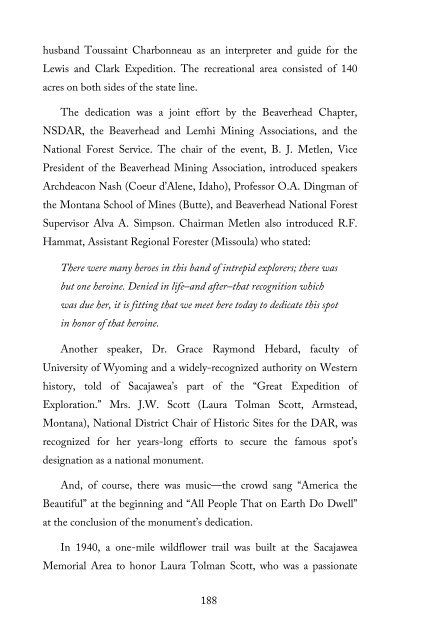Montana's DAR Markers . . . Honoring Where History Was Made
This book is a 200-page thank you to the women of Montana State Society Daughters of the American Revolution for their work in placing historical markers across the state of Montana. Starting in 1908, Montana DAR has installed 70 historical markers across the state. Of those, 33 remain. This book records why the markers’ sites were selected, their history, and the backstory of each.
This book is a 200-page thank you to the women of Montana State Society Daughters of the American Revolution for their work in placing historical markers across the state of Montana. Starting in 1908, Montana DAR has installed 70 historical markers across the state. Of those, 33 remain. This book records why the markers’ sites were selected, their history, and the backstory of each.
You also want an ePaper? Increase the reach of your titles
YUMPU automatically turns print PDFs into web optimized ePapers that Google loves.
husband Toussaint Charbonneau as an interpreter and guide for the<br />
Lewis and Clark Expedition. The recreational area consisted of 140<br />
acres on both sides of the state line.<br />
The dedication was a joint effort by the Beaverhead Chapter,<br />
NS<strong>DAR</strong>, the Beaverhead and Lemhi Mining Associations, and the<br />
National Forest Service. The chair of the event, B. J. Metlen, Vice<br />
President of the Beaverhead Mining Association, introduced speakers<br />
Archdeacon Nash (Coeur d’Alene, Idaho), Professor O.A. Dingman of<br />
the Montana School of Mines (Butte), and Beaverhead National Forest<br />
Supervisor Alva A. Simpson. Chairman Metlen also introduced R.F.<br />
Hammat, Assistant Regional Forester (Missoula) who stated:<br />
There were many heroes in this band of intrepid explorers; there was<br />
but one heroine. Denied in life–and after–that recognition which<br />
was due her, it is fitting that we meet here today to dedicate this spot<br />
in honor of that heroine.<br />
Another speaker, Dr. Grace Raymond Hebard, faculty of<br />
University of Wyoming and a widely-recognized authority on Western<br />
history, told of Sacajawea’s part of the “Great Expedition of<br />
Exploration.” Mrs. J.W. Scott (Laura Tolman Scott, Armstead,<br />
Montana), National District Chair of Historic Sites for the <strong>DAR</strong>, was<br />
recognized for her years-long efforts to secure the famous spot’s<br />
designation as a national monument.<br />
And, of course, there was music—the crowd sang “America the<br />
Beautiful” at the beginning and “All People That on Earth Do Dwell”<br />
at the conclusion of the monument’s dedication.<br />
In 1940, a one-mile wildflower trail was built at the Sacajawea<br />
Memorial Area to honor Laura Tolman Scott, who was a passionate<br />
188





